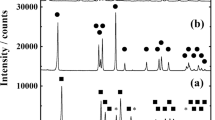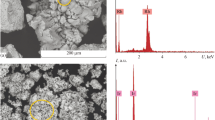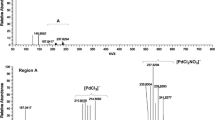Abstract
To improve the safety of the Pd recovery processes that use toxic oxidizers, dissolution of Pd in hydrochloric acid with alkali metal palladates was investigated. Alkali metal palladates were prepared by calcining a mixture of Pd black and alkali metal (Li, Na, and K) carbonates in air. Almost the entire amount of Pd was converted into Li2PdO2 after calcination at 1073 K (800 °C) using Li2CO3. In contrast, PdO was obtained by calcination at 1073 K (800 °C) using Na and K carbonates. Our results indicated that Li2CO3 is the most active reagent among the examined alkali metal carbonates for the formation of palladates. In addition, dissolution of the resulting Li2PdO2 in HCl solutions was evaluated under various conditions. In particular, Li2PdO2 rapidly dissolved in diluted (0.1 M) HCl at ambient temperature. Solubility of Pd of Li2PdO2 was found to be 99 pct or larger after dissolution treatment at 353 K (80 °C) for 5 minutes; in contrast, PdO hardly dissolved in 0.1 M HCl. The dissolution mechanism of Li2PdO2 in HCl was also elucidated by analysis of crystal structures and particulate properties. Since our process is completely free from toxic oxidizers, the dissolution process via alkali metal palladates is much safer than currently employed methods.











Similar content being viewed by others
References
Johnson Matthey Plc.: Platinum 2013 interim review, London, UK, 2013.
Y. Furuse: Mineral Resources Report, JOGMEC, 2012, pp. 477–98.
D. Jollie: Platinum 2007, Johnson Matthey Plc., London, 2007.
Y. Furuse: Mineral Resources Report, JOGMEC, 2013, pp. 581–95.
D.R. Lide, ed.: CRC Handbook of Chemistry and Physics 82th edn., CRC Press, Boca Raton, 2001, pp. 5-4–5-60.
M. Baghalha, H. Khosravian Gh and H.R. Mortaheb: Hydrometallurgy, 2009, vol. 95, pp. 247–53.
J.H. Potgieter, S.S. Potgieter, R.K.K. Mbaya and A. Teodorovic: J. S. Afr. Inst. Min. Metall., 2004, vol. 104, pp. 563–72.
J.E. Barnes and J.D. Edwards: Chem. Ind., 1982, vol. 6, 151–55.
T.H. Okabe and K. Nose: The Latest Technological Trend of Rare Metals, Chapter 9-3, CMC, 2012.
R. Kasuya, T. Miki and Y. Tai: J. Ceram. Soc. Jpn., 2013, vol. 121, pp. 261–64.
R. Kasuya, T. Miki, H. Morikawa and Y. Tai: J. Ceram. Soc. Jpn., 2013, vol. 121, pp. 884–90.
R. Kasuya, T. Miki, H. Morikawa and Y. Tai, Int. J. Miner. Process., 2014, vol. 128, pp. 33–39.
E. Jackwerth and S. Gomišček: Pure Appl. Chem., 1984, vol. 56, pp. 479–89.
H. Zhang, J. Gromek, G.W. Fernando, S. Boorse and H.L. Marcus: J. Phase Equilib., 2002, vol. 23, pp. 246–48.
H.P. Klug and L.E. Alexander: X-ray diffraction procedures: for polycrystalline and amorphous materials. Wiley, New York, NY, 1974.
I. Barin and O. Knacke, ed.: Thermochemical Properties of Inorganic Substances, Springer-Verlag, New York, NY, 1973.
B.L. Dubey, J.A. Gard, F.P. Glasser and A.R. West: J. Solid State Chem., 1973, vol. 6, pp. 329–34.
M.J. O’Malley, H. Verweij and P.M. Woodward, J. Solid State Chem., 2008, vol. 181, pp. 1803–09.
K. Momma and F. Izumi: J. Appl. Crystallogr., 2011, vol. 44, pp. 1272–76.
L.I. Elding, Inorg. Chim. Acta, 1972, vol. 6, pp. 647–51.
F.L. Bernardis, R.A. Grant and D.C. Sherrington: React. Funct. Polym., 2005, vol. 65, pp. 205–17.
Y. Kawano, R. Morita, T. Matsui, K. Kondo and F. Nakashio: J. Chem. Eng. Jpn., 1990, vol. 23, pp. 611–15.
T. Sato, T. Takayanagi and K. Sato: J. MMIJ, 2011, vol. 127, pp. 526–32.
Acknowledgment
This study was supported by a Grant-in-Aid for Challenging Exploratory Research, No. 23656566 from The Naito Science & Engineering Foundation.
Author information
Authors and Affiliations
Corresponding author
Additional information
Manuscript submitted July 10, 2014.
Rights and permissions
About this article
Cite this article
Kasuya, R., Miki, T., Morikawa, H. et al. Dissolution Process of Palladium in Hydrochloric Acid: A Route via Alkali Metal Palladates. Metall Mater Trans B 46, 2476–2483 (2015). https://doi.org/10.1007/s11663-015-0431-x
Published:
Issue Date:
DOI: https://doi.org/10.1007/s11663-015-0431-x




